COVER STORY:
Yoga - The Art of Transformation: SF Asian Art Museum Exhibition
Yoga is regarded around the world as a path to health and spiritual insight. Many people are aware of its origins in India. But the motivations that compelled countless individuals to pursue yogic paths over the past 2,500 years are less well known.
Borrowed from 25 museums and private collections in Europe, the U.S. and India, the artworks featured in the exhibition date from the 2nd to the 20th centuries. Yoga: The Art of Transformation goes beyond postures and delves into how yoga has evolved into a global phenomenon through an exploration of its visual history. The Asian Art Museum is the only U.S. West Coast venue for this exhibition, writes Dr. Qamar Adamjee.
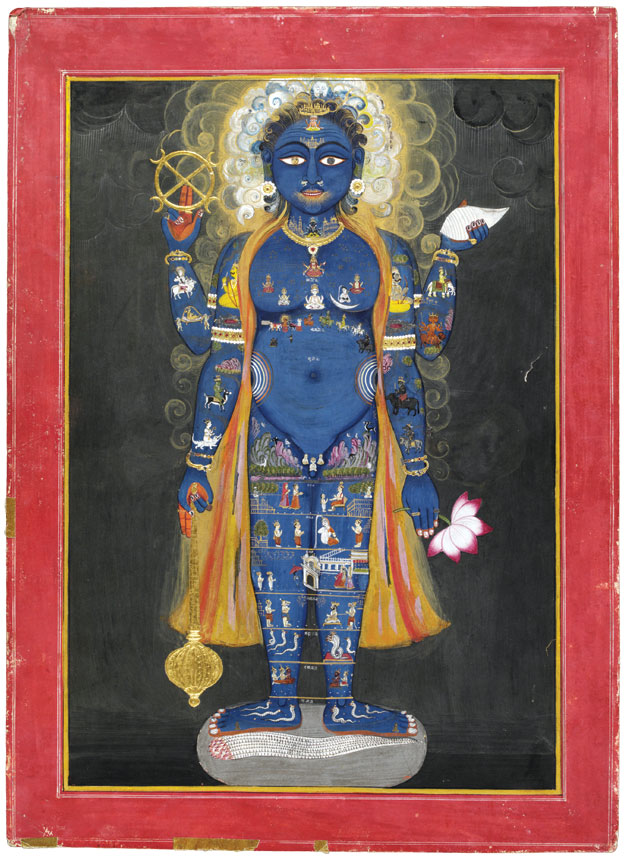
(Above): Vishnu Vishvarupa, approx. 1800–1820. India; Rajasthan state, former kingdom of Jaipur. Opaque watercolor and gold on paper. Courtesy of the Victoria and Albert Museum, London, Given by Mrs. Gerald Clark, IS 33–2006.
The Hindu deity Vishnu’s sun-and-moon eyes and fire-blazing mouth are among the “Bhagavad Gita’s” descriptions of Krishna, an incarnation of Vishnu in his infinite cosmic form (Vishvarupa). This small but powerful painting depicts the universe as Vishnu standing upon the multi-headed serpent Shesha and holding in his four arms a discus, conch, lotus and mace. Various deities cluster in Vishnu’s upper torso, the phenomenal worlds appear as target-like circles at his waist, and the seven netherworlds constitute his legs.
Yoga is regarded around the world as a path to health and spiritual insight. Many people are aware of its origins in India. But the motivations that compelled countless individuals to pursue yogic paths over the past 2,500 years are less well known. Few people are familiar with yoga’s rich diversity—the different schools of practice that developed over the centuries, and yoga’s varied meanings for practitioners and those they encountered.
The many forms of yoga familiar to practitioners today—raja yoga, kriya yoga, vinyasa yoga, ashtanga yoga, anusara yoga and others—are relatively recent developments in yoga’s long history and have emerged in only the past 120 years, formulated by Indian and Western teachers.
Yoga’s origins are debated. The Vedas, the primary texts of orthodox Hinduism, composed around 2000-1000 BCE, contain fleeting references to flying long-haired sages that suggest an ancient mystic tradition. But it is not until several centuries later that we find the strongest evidence for the emergence of yogic techniques and goals.
By around 500 BCE, yoga started to acquire its more familiar meaning. During this time, wandering ascetics of the Hindu, Buddhist and Jain religions developed practices for controlling the body and breath as a means of stilling the mind. Their goal was to transcend the suffering that is inherent in human existence.
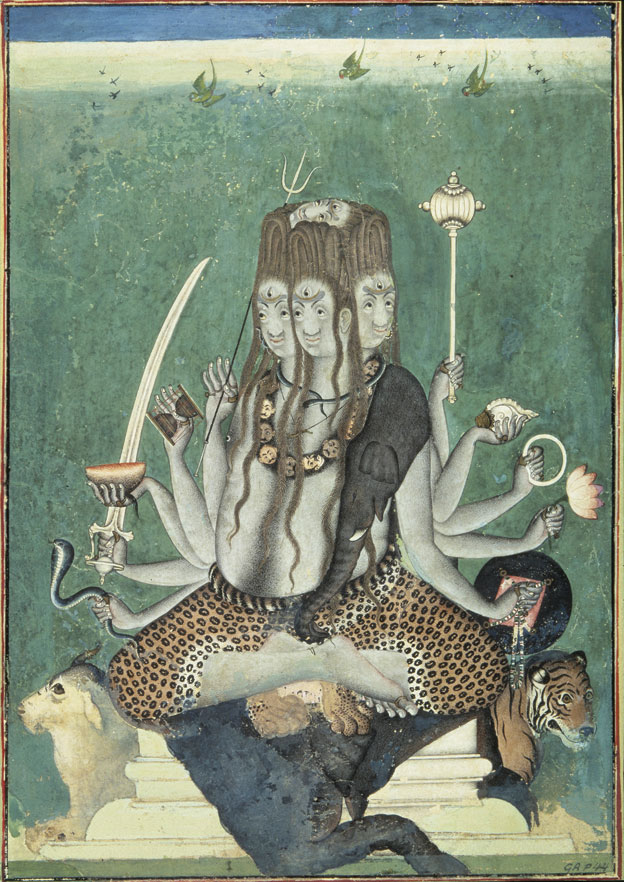
(Above): The five-faced Shiva, approx. 1730–1740
India; Himachal Pradesh state, former kingdom of Mandi
Opaque watercolor on paper
Victoria and Albert Museum, London, Given by Col. T. G. Gayer-Anderson and Maj. R. G. Gayer-Anderson, Pasha, IS 239-1952
Sadashiva, the Hindu deity Shiva in his role as the “eternal and supreme,” represents a higher level of the universe in which there are no distinctions among person, body, and world. Sadashiva’s five faces (here, the fifth is hidden behind the others, and the fourth sits atop the rest) signify five streams of knowledge. His other attributes are a third eye, an ascetic’s garb, and, clockwise from top right, a mace, conch shell, discus or noose, lotus, shield, snake, sword, skull cup, drum, and trident.
By meditating on Sadashiva, devotees aim to achieve an essential oneness with the deity.
Texts from around 400–200 BCE laid the groundwork for much of what later came to constitute yoga. These texts introduced the concept of an individual self that is equivalent to the all-encompassing Absolute, a supreme, immeasurable, and transcendent essence that permeates all creation (often known in Hindu systems as brahman). The pivotal text Yoga Sutras, by Patanjali, was compiled between the 2nd and 4th centuries from earlier yoga and meditation traditions. Its overarching purpose, as with nearly every other Indian religious and philosophical system, was to resolve the problem of suffering. In subsequent centuries, numerous traditions emerged, including new texts that adapted, expanded and reinterpreted the knowledge base that constitutes yoga. A yogic physiology of the body was also first outlined in this period.
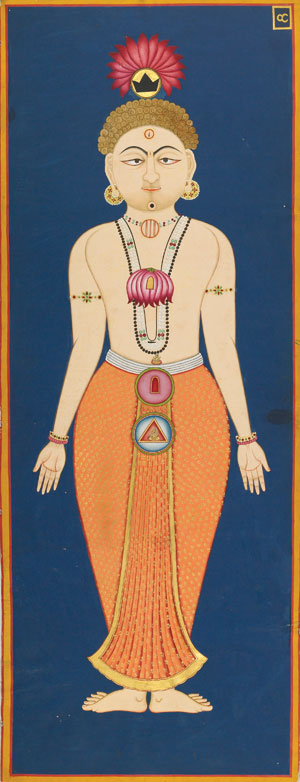 (Right): The “chakras” of the subtle body, page 4 from a manuscript of the “Siddha Siddhanta Paddhati,” 1824, by Bulaki (Indian, active early 1800s). India; Rajasthan state, former kingdom of Marwar, Jodhpur. Opaque watercolor and gold on paper. Courtesy of the Mehrangarh Museum Trust, RJS 2376. (Right): The “chakras” of the subtle body, page 4 from a manuscript of the “Siddha Siddhanta Paddhati,” 1824, by Bulaki (Indian, active early 1800s). India; Rajasthan state, former kingdom of Marwar, Jodhpur. Opaque watercolor and gold on paper. Courtesy of the Mehrangarh Museum Trust, RJS 2376.
Energy centers of the body (“chakras”) are typically aligned along the body’s central channel, but they are conceptualized somewhat differently in various yoga treatises, and their numbers vary. Today, seven is widely accepted as the standard number of “chakras,” and their symbols are fixed.
Painted with mineral colors, this large page from a monumental manuscript depicts nine “chakras” on the body of a Nath yogi whose eyes are crossed in inward meditation. The artist, Bulaki, represented the “chakras” both abstractly and figuratively. The absolute emptiness (“shunya”) that is the sixth “chakra” (located near the roof of the mouth) appears as a black circle on the yogi’s chin; “Kundalini Shakti,” here the third “chakra,” is represented by a goddess sitting atop the snake coiled around the yogi’s waist.
In yoga, the body is both what must be transcended as well as the necessary tool for attaining enlightenment. The paradox of the yogic body is powerfully expressed in sculptures and paintings that represent austerities—rejections of material attachment—through various acts of renunciation and extreme self-denial.
Sages and yoga-practicing ascetics perform austerities to generate a transformative, purifying heat and create spiritual knowledge and power. Fasting, celibacy, meditating for long periods in intense heat or cold and immobilizing the body in difficult positions are classic forms of austerities.
Many yogic paths adopted austerities as methods for breaking bonds with society and generating the spiritual heat that enabled practitioners to “perfect” the body, expand consciousness and gain supernatural powers. Later hatha yoga traditions also assimilated the austerities that held the body in challenging positions, and refined them into yogic postures (asanas).
Today, it is widely recognized that yoga has quantifiable health benefits. The origins of this acceptance lie at the turn of the 20th century, when Indian teachers and medical professionals began applying the concepts, vocabularies, symbols and measures of science to the yogic body. Through rigorous physiological experiments that were illustrated and published, these doctors refashioned hatha yoga as a scientifically legitimized therapeutic regimen.
The range of practices that we know as yoga today is the product of some 2,500 years of transformation.
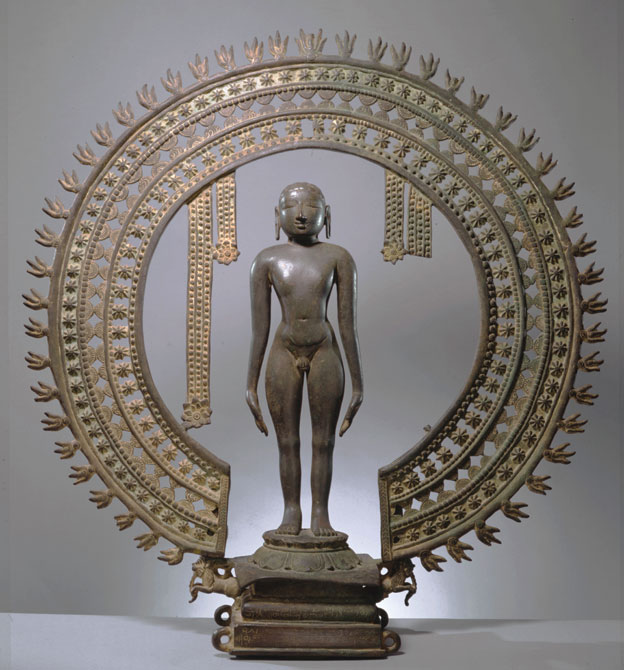
(Above): Standing–Jina, 1000-1100. India; Tamil Nadu state. Bronze. Courtesy of Private Collection.
The Jina, the enlightened being in the Jain religion, meditates in the blissful, accomplished state of freedom from the material world. He stands in an erect pose, which according to Jain cosmology is the very form of the universe. In Jain practice, symmetrical poses dispel the restraining substances that obscure the innate luminosity of the soul. An elaborate halo radiates the Jina’s energy outward.
Yoga: The Art of Transformation explores a largely untapped resource — visual culture — to illuminate key aspects of yoga practice as well as its hidden histories. With sculpture, paintings, illustrated manuscripts, prints, photographs, books, and films, it is the first art exhibition to survey the centrality of yoga in Indian culture.
The exhibition focuses on the continuities and ruptures that emerge over time as visionary teachers (whether in the 10th or the early 20th century) adapt yogic practices and goals to their current times. The exhibition’s themes include an exploration of the key elements of yoga practice and yogic conceptions of the body; the role of teachers; the importance of place in yoga practice; the associations between yoga and power; and the ways in which yogis have been understood and imagined in Indian and Western cultures. The exhibition concludes with the emergence of modern yoga as a regimen for health, fitness and spiritual wellbeing.
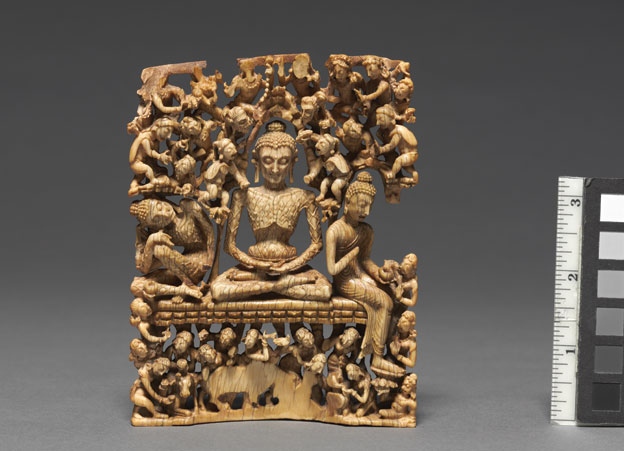
(Above): Fasting Buddha, 700–800. India; Jammu and Kashmir state. Ivory. Courtesy of the Cleveland Museum of Art, Leonard C.
Hanna, Jr. Fund, 1986.70
An intricately carved ivory depicts, in three successive scenes, the future Buddha’s early experimentation with fasting until his limbs withered. At center, with his gaunt body encased in a delicate spiderweb of veins, he meditates in lotus posture during his six-year subsistence on a daily grain of rice. Hunched over, on the left, he remains in a state of despair. Ultimately, as seen on the right, he accepts a food offering that restores his robust body and sets him on the final path toward enlightenment.
The exhibition’s 135 impressive artworks, from 25 museums and private collections in Europe, the U.S., and India, including the Asian Art Museum’s collection, shed light on yoga’s meanings and philosophical depth, the practice’s significance within Indian culture and religion, its movements across communities, and the genius of artists who transformed profound concepts into material form.
The Asian Art Museum is the only U.S. West Coast venue for this exhibition.
|